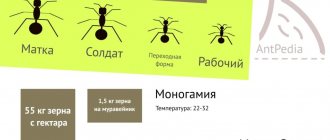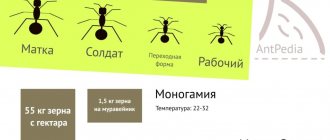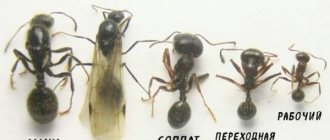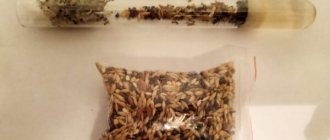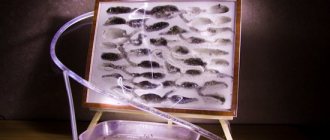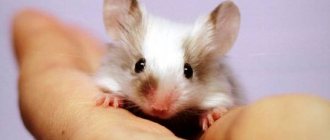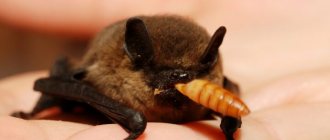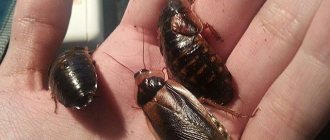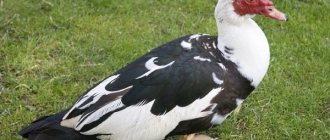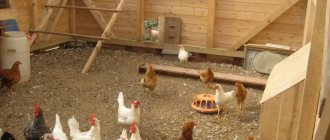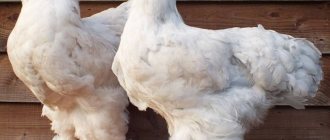Creating an ant farm at home or office is becoming increasingly popular. Unpretentious harvester ants are best suited for this. Before getting these insects, it is worth familiarizing yourself with their species characteristics: way of life, habitat, exterior, characteristics of reproduction and maintenance.
General information about the genus Messor
The genus Messor includes 110 species of ants adapted to life in the desert zone on almost all continents. Thus, 30 species live in Europe alone, 5 of them in Russia. This:
- Messor aciculatus;
- Messor denticulatus;
- Messor kasakorum;
- Messor rufitarsis;
- Messor constructor.
The genus received the name Messor (reaper) due to the method of collecting grain from the fields. The specificity of nutrition is determined by the nature of vegetation in the desert climate. According to research, ants from one family are able to bring up to 1.5 kg of grain to underground storage facilities. The answer to the question: is the harvester ant a pest that steals the fruits of human labor should be answered in the negative. He harvests his harvest only from the ground, from already damaged spikelets. The grains are stored in moist underground chambers for a long time and periodically germinate. Then the ants chew off the seedlings, and the seeds themselves are ground into powder, moistened with saliva and fed to the larvae.
Reaper ants have their own characteristics:
- large size of individuals;
- peacefulness;
- swarming, nest building in spring.
Let us consider this genus in more detail using the example of the species Messor structor (steppe harvester ant).
Biology
Stoyanov et al. (2015) — Messor constructor
are harvester ants storing seeds in underground granaries.
Being major seed consumers in xeric habitats they influence the vegetation by depleting and dispersing seeds (Azcarate, Peco 2003, MacMahon et al. 2000, Schlick-Steiner et al. 2005). According to Seifert (1996), Central European populations of the harvester ant genus Messor are currently considered to constitute a single species Messor constructor
.
It has been reported that M. constructor
ants live mainly in polygynous colonies and could be members of unicolonial populations (Schlick-Steiner et al. 2005).
Messor constructor
is one of the most widespread steppe species. It is well adapted to different conditions and occurs in all of Europe. In Bulgaria this ant is found all over the country in medium-sized populations and occur in plain desolate terrains, mountainous slopes, outskirts of mixed woodland zones and in open well-drained areas such as abandoned fields, pastures, and overgrown laws.
This study examined genetic variability among populations of Messor constructor
from various localities (n=36 nests) in from Southern Bulgaria using isoenzymic analysis. Three of the four enzyme loci used were found to be polymorphic. Observed and expected heterozygosities (Ho and He) ranged from 0.0 to 0.111 and from 0.168 to 0.372, respectively. Nei's (1972) genetic distance was found to range from 0.001 (between Boliarino and Lubenova mahala) to 0.462 (between Chirpan and Merichleri). The estimated mean F-IS and F-ST values from isozyme data were 0.8738 and 0.1432, respectively. Two of the studied populations were grouped separately in dendrograms as compared to all other populations which formed a large cluster consisting of three sub-clusters.
mtDNA. Thirty-one haplotypes of COI (1375 bp) known; (GenBank).
Description and features of the Messor constructor type
The steppe harvester ant is the largest among other ants of the subfamily Myrmicinae. The color is dark, reddish-brown. The length of the working insect varies from 4 to 9 mm, the queen – up to 11-15 mm. The body consists of three parts: head, chest, abdomen, connected to each other by jumpers, due to which insects are flexible and mobile. The massive square head of the ant is equipped with jaws-mandibles, which, when bitten, close like a trap. This is convenient for carrying food and crushing grains.
This is interesting: the terrifying jaws of the harvester ant are not an attack weapon, but a device for processing grain.
The workers have stingers that they use for self-defense. Ants are clumsy and slow; When irritated, they choose to run away. The species is characterized by sexual polymorphism, that is, the presence of different forms of individuals: females, males, workers, soldiers and transitional forms. Each category of harvester ants performs its duties.
When studying the question of how long harvester ants live, information was obtained that the worker lives up to 3-5 years, and the queen lives up to 20 years.
Reapers live in families of up to 5,000 individuals. The ground part of the anthill looks like a hole, surrounded by a rampart of earth and debris from the grains brought in. Under the ground, the nest looks like an extended vertical tunnel, with passages with cameras running off the sides. The family has been using one house for several years.
Lifespan of infertile females
When determining the bulk of insects in an ant community, one must take into account not so much calendar time as how ants live in each climate zone. And it’s better to count in months.
The lifespan of a non-hibernating insect in the tropical jungle is 1 year or 12 months. The lifespan of an ant near the polar zone is 3–4 years. But the latter are active only 3 months a year. The insects spend the remaining 9 months in suspended animation, in which the vital activity of their body slows down almost to zero. As a result, the life expectancy of a circumpolar ant is the same 12 months as that of a tropical ant.
The ant occupies a considerable niche in the world of living beings. He is hardworking, responsible, active throughout his life and is ready to sacrifice himself for the good of the entire anthill. Individual individuals act so coherently that a nest of ants is sometimes called a superorganism. How long an ant lives often depends on its species and caste.
The ant community is divided into workers, males and queens (or queens). The female has the longest life. She lives on average from 12 to 20 years.
Science knows of a case where a queen ant lived for 28 years. The individual was kept in laboratory conditions.
How long do different types of ants live?
It has been noticed that the lifespan of an ant depends on its proportions. The smaller it is, the shorter its life. The average life history of an ant is something like this:
- The queen ant lives for about 12-20 years, as mentioned above. A female bulldog ant can live up to 22 years;
- Working individuals (food gatherers, soldiers, nannies and others) live for about several months to three years, tropical ants can live up to 5 years;
- Males live the shortest. Their task is simple: to mate with a female, after which they will be killed by their own relatives or predators. They live for several weeks, although there are species of ants where the male lives for years.
Typically, the anthill population is renewed almost completely within a year.
Difficult royal life
The queen ant lives 15-20 times longer than the other members of the anthill, and is provided by the family with everything necessary. However, it is wrong to consider her the main member of the community. She is subordinate to the needs of working individuals, she is constantly moved from place to place, and can be transferred for exchange to another nest. When the female's reproductive capacity declines, she may be killed. In anthills, where there is not one, but several queens, their living conditions are more difficult than in families with one queen.
There are species of ants without a queen.
The workers' commune and its talents
Ants inhabit almost the entire planet, except Antarctica, Greenland, Iceland and several oceanic islands. Where they appear, a lot changes, because the ants work with incredible dedication.
What does an ant do? If the division into castes is conditional, then in the first days of life the insect takes care of the larvae and the female, then becomes a builder, digs passages, and after that it is a food getter, or forager.
The more civilized and organized the anthill, the more responsibilities are divided among its members. An ant can do one thing all its life; there is a division of responsibilities among ants into 29 functions.
Habitual ideas about insects as narrow-minded creatures collapse when it comes to ants. These Hymenoptera not only collect food, but also create common shelter and protection for each other. They are capable of:
- Overcome vast distances;
- Communicate using pheromones, physical signals, tapping and acoustic communication even during the pupal stage;
- Find and indicate the optimal path to other members of the anthill to the food source;
- Train young individuals in an interactive way;
- Choose your role in the community, thanks to the experience gained;
- Herd and protect “pets” such as aphids;
- Cultivate mushrooms;
- Team up with other species to defeat a common enemy;
- Transfer plant seeds;
- Destroy pests;
- Increase soil productivity in hot and dry climates by about a third.
How dangerous are ants?
Ants become carriers of viruses and diseases, and in some cases harm agriculture. Insects invade people's homes and beehives, where they look for sweet and meaty food.
Appearance of harvester ants and their habitat
The body of insects consists of three parts - the head, thorax and abdomen. They are connected to each other by movable jumpers, which makes the reapers very flexible. There are three pairs of limbs on the chest. The large head has powerful jaws - mandibles, which are convenient for carrying food and grinding seeds and grains. The color of the ants is dark, reddish-brown. Their length is considered one of the largest among other families of ants: worker ants have a length of 4 to 9 mm, while the queen reaches truly enormous sizes - from 11 to 15 mm.
The steppe ant differs from other representatives of the ant family by its characteristic reddish-orange color
Harvester ants live in steppes, semi-deserts and deserts in Asia, North and South Africa and America.
Messor kasakorum
often confused with the previous species, but they still have differences. If you do not examine the hairs and other small details under a microscope, then Casacorum is not such a bright denticulatus, in the color of which the glossy black cover of the head and abdomen becomes matte, and the color of the chest of some is brown.
Sometimes the two-color color may not appear for a very long time; most often large workers have it, while the rest are simply black.
How is an anthill organized?
Up to 5 thousand individuals can live in an anthill
In a colony of harvester ants there is a strict hierarchy: each family member is busy with his own business. The family consists of a queen - she produces offspring, soldiers - they protect the anthill from dangers and help with harvesting, worker ants - they are engaged in obtaining food and caring for the young. There are also males and females - they mate with each other, creating new colonies.
From the outside, the anthill's shape resembles a volcano
The ground part of the ants' home is a hole in the soil, along the edges of which there is a shaft of earth and debris from the prey they bring. The underground part has a vertical tunnel, from which passages with cameras extend on the sides. In these rooms, ants set up pantries for storing food and “children’s rooms” in which they store larvae.
What is an anthill from the point of view of social structure
It is difficult to answer whether it is a privileged individual, since without it the life of an anthill loses its meaning. Worker ants cannot reproduce, but they are the ones who decide when to kill the queen who has reduced her reproductive rate. The more queens there are in an ant family, the less “respectful” the workers are to them. If we draw an analogy with human society, a comparison with a palace coup suggests itself.
Queens are long-lived. The average lifespan is 12 -20 years. Young queens, which they gnaw off after fertilization. Sometimes some of the queens remain in the anthill, duplicating the old queens. The other part, after the mating summer, finds a convenient place and prepares a new anthill.
Queens' resources are very limited. She may lay a small number of eggs the first time and often feeds the hatched larvae with eggs specially designed for this purpose. Because of this, in a new place in an anthill, several ants of the first generation are always very small, sometimes dwarf. Working insects begin to provide their anthill with food, and subsequent generations become larger and larger until they reach a normal size for the species.
Males
Coming out of hibernation, the queen makes the first clutch, from which new males and females emerge. Males also have wings. Their life is short. Afterwards, the males die, since parasites are not needed in the anthill.
Having fulfilled her duty to procreate, the queen begins to lay eggs, from which infertile females emerge - worker ants. The social structure of an anthill involves the division of worker ants into more specialized subclasses:
- Nannies. The youngest ants. Busy caring for eggs and larvae.
- Breadwinners. Ants courting the queen.
- Shepherds. In those species that, special ants look after the “ladies”.
- Honeydew collectors. Insects that collect the sweet secretions of aphids.
- Mushroom growers. A specific class of leaf-cutter ants.
- Workers on the anthill. They are engaged in repairing the home, maintaining the necessary humidity in it and ventilating the anthill.
- Foragers. One of the last stages of insect life. They provide an anthill by collecting it everywhere. The lives of foragers are of little value. Among them is the highest percentage of deaths. The functions of foragers are performed by the oldest members of the anthill.
- Soldiers. The largest members of the ant family. They act as protectors of the anthill.
Throughout the life of an ant, the functions performed by the same individual change. For this reason, it is impossible to speak with confidence about the caste structure of the ant community.
Soldiers
A relatively privileged “class”, not excommunicated from the anthill, but essentially being very large and, most likely, the oldest representatives of the working class.
Habitat
The steppe harvester ant is a resident of the steppes and deserts. Its nests can be found in the countries of the Mediterranean coast, Southern and Eastern Europe, the Caucasus, Middle and Central Asia, Afghanistan, Iran, Iraq, Lebanon, Syria, and Israel. On the territory of Russia, in the Republic of Tatarstan, the species is included in the Red Book due to the threat of extinction.
Years
Reapers are ants of deserts and steppes. Such a life developed an interesting feature in them. Almost all species of ants we encounter raise young males and females in the spring, so that by the end of spring or summer they can fly away and give rise to new colonies. The Messors have a completely different strategy: young individuals capable of reproducing are raised not in May, but in August. Next, the winged generation overwinters in its native anthill and flies out by the end of April. At a time when the queens of other ants are still in the larval state, messoras are already beginning to raise the first generation of new workers. It would seem, why such oddities? The answer is simple: in steppes and semi-deserts, the most favorable conditions for the creation of new colonies appear in the spring, when the average daily temperature is not so high and soil moisture remains.
Messor ebeninus
has long been the butt of jokes due to the transcription of the species name, but in reality it alludes to color (“ebeninus” - “ebony”, having the color of ebony). These reapers live in the countries of the Middle East, from where they are periodically brought to us.
They inhabit deserts, feeling great there. They have adapted to feed on dry seeds, managing to extract an insignificant amount of water from there, and they dig their anthills to the groundwater level.
What do harvester ants eat?
Particular attention should be paid to the feeding and extraction of food by the reapers. Since they most often feed on grain crops, ants were long thought to be agricultural pests. However, research has shown that insects only harvest crops that directly fall to the ground.
Reserves
The gathering of provisions is very interesting among the reapers. As stated earlier, the harvesting of grain occurs when it is on the ground.
The workforce collects about 1.5 kg of grain crops from the fields in one season
Scientists have found that harvester ants send out workers as much as there is available food. If there is a lot of it, then the workers return faster and the number of ants sent for food increases. But if they return slowly, then the number of ants sent out decreases or stops altogether.
To store grain, hardworking reapers set up special rooms deep underground. In damp, warm rooms, the seeds begin to germinate, and as soon as the first sprouts and roots appear, the ants immediately destroy the shoots. After this, large soldier ants grind the grain into powder with their powerful jaws and, moistening it with saliva, feed this mixture to the larvae.
Nutrition
It can be said about ants that almost all of them are predators, scavengers, and also feed on plant foods (adults eat carbohydrate foods, larvae eat protein foods). They find food not only on the ground, but also an ant on a tree in search of food is a common occurrence. For protein food, they eat invertebrates, mainly insects: they pick up corpses, hunt and even raise livestock (aphids).
They get carbohydrate food from honeydew: it is given to them in abundance by their cattle and aphids (except that aphids secrete a special liquid, which red, red and black ants eat with pleasure, and the aphids themselves act as meat). They also feed on seeds, plant sap, nectar, and mushrooms (they often grow the mushrooms they need on their own).
They take all the prey to the anthill, where they distribute it among themselves (they never eat on the side). There are species that have a process in the esophagus, nicknamed the “social stomach”: in it, insects store food during transportation, and, having delivered it to the place, remove it, and then distribute it among the ants.
https://www.youtube.com/watch?v=6cqXS7akwBw
Reproduction
Living conditions even affected the breeding habits of reapers. Most ants raise sexually mature individuals by late spring or early summer. Reapers emerge in late summer, spend the winter in the nest, and begin breeding in April. This gives them the opportunity to build an anthill under favorable conditions, while the steppe soil is not dry and the ambient temperature is not yet so high.
Each harvester ant nest contains one queen. At the stage of nest formation there may be several of them, but then the ants expel or eat the extra ones. The males, having fertilized the female, die.
The harvester ant is an insect with a full development cycle: egg, larva, pupa, adult. The first three stages take up to 2-3 weeks each. Reaper ants are characterized by two methods of reproduction: asexual and sexual. Asexual is represented by parthenogenesis, it leads to the birth of worker ants. In the sexual method, males and females are born.
Research results and discussion
The studied groups were observed under various conditions associated with changes in temperature and nest size.
The control group was observed under standard conditions: +25…+28°С; 2/3 of the living volume of the incubator; absence of external stimuli (bright light, constant vibrations, loud noise). Group A was kept at a low temperature (+21...+25°C) and in the absence of irritants, the volume of detention was limited (Oo; 1/3 of the living volume of the incubator), large (Bo; 4/5 of the living volume of the incubator) and standard (Co) . Group B was kept at standard temperature and in the absence of external stimuli, the volume of detention was the same as in the previous group. Group B was kept under variable conditions: temperature fluctuations (+21...+28°C), some irritants were present, such as short-term vibrations, dim light, noise; the volume of content is the same as for other test groups.
Observations of the ants were carried out over 10 weeks; changes in the development of the colonies were recorded every week. The data is presented in Table 1.
Table 1 – Observation data for test ant colonies
| A week | Group A (reduced t) | Group B (standard t) | Group B (variable t) | Group K (control group) | ||||||||||||
| Ooh | Bo | Co | Co | Ooh | Bo | Co | Co | Ooh | Bo | Co | Co | |||||
| 1 | PYA | PYA | PYA | PYA | PYA | PYA | PYA | PYA | PYA | PYA | PYA | PYA | PYA | PYA | PYA | |
| 2 | PYA | GM VL | VL | VL | VL | GM VL | VL | VL | VL | GM VL | GM VL | VL | ||||
| 3 | VL | VL | VL | VL | VL | |||||||||||
| 4 | GM | GM | GM | GM | ||||||||||||
| 5 | ||||||||||||||||
| 6 | OL | OL | OL | OL | OL | OL | OL | GM OL | OL | GM OL | OL | GM OL | OL | OL | OL | GM OL |
| 7 | ||||||||||||||||
| 8 | PI | PI | PI | PI | PI | GM PI | PI | PI | PI | GM PI | PI | GM PI | PI | PI | PI | PI |
| 9 | PS | PS | PS | GM PS | PS | PS | PS | GM | PS | PS | PS | PS | PS | PS | ||
| 10 | GOM | |||||||||||||||
Conventions. PPY – appearance of egg packets; VL – hatching of larvae; GM – death of the uterus, GOM – death of both uteruses; OL – pupation of larvae; PI – emergence of imago; PS – feeding with seeds.
In the first week, all queens from the colonies laid eggs, but the brood of queens from group A in the large incubator was noticed only in the second week. In groups B, C and C, larvae hatched from eggs also in the second week; two queens from the control group and one each from groups B and C died due to injuries, presumably from other queens in the colonies. Injury during the move-in and natural injuries should be excluded from assumptions, since there were no such injuries during the examination in the first week. During the third week of incubation, the emergence of larvae was observed in group A. During the fourth week of the experiment, each group lost another queen in the queen colonies.
Brood pupation was observed in the sixth week of the experiment, but this presumably could have happened a week earlier, groups B and K lost one queen each, group B lost 2 queens. Death also occurred due to injuries incompatible with life. The emergence of the first worker adults was observed during an examination on the eighth week of incubation; group B lost another queen; group C lost two queens in monoqueous colonies, as a result of which the workers and brood were transferred to colonies of reapers not included in the experiment. This event was inevitable, since during the manifestation of aggression, both uteruses received damage in the form of bitten off paws and antennae. Presumably, queens that lost both antennae lost their orientation and sense of smell and eventually died. Messor muticus ants have a sting, but are not able to use it, so they can only inflict injuries with the help of their mandibles. During the inspection on the ninth week, the colonies were fed with poppy and amaranth seeds. In group A a dead queen was found, in group B another queen was found, but in a monoqueous colony. The brood and workers of colonies that had lost both queens were transferred to colonies not included in the experiment.
During the final inspection of the test colonies in the tenth week, another completely orphaned colony from group A was discovered, where two dismembered queens were found, presumably by worker ants. It is possible that the queens initially showed aggression towards each other, but the workers took action to eliminate the aggression factor. During the experiment, only one colony from group A was able to maintain dimatosis (Fig. 2).
Figure 2 – Dymatous colony of harvester ants Messor muticus (photo by M.A. Arbuzov, 2022)
As can be seen from the results, factors such as temperature and stress have almost no effect on the rate of development and brood formation, however, temperature and stress have a greater effect on the behavior of adults, including oviparous females. As a result of the experiment, only one colony, which grew at a low temperature and a sufficiently large volume of living space, retained its dimate quality; the remaining colonies either lost one of the queens or were completely orphaned, losing both queens. The appearance of working individuals also helps to reduce the number of egg-laying females if there is aggression and hostility between them.
How long does a queen ant live?
So how long does a queen ant live? Unfortunately, it is quite difficult to give an exact answer to this question: it very much depends on the type of insect. There are species whose queens live for as long as not every cat or dog can live - 20 years... Just think about this figure! True, female pharaoh ants, which people most often want to get rid of, are still not record long-livers: their life expectancy is a maximum of 2 years under favorable conditions.
By the way
Red ants are a species that is often found in the middle zone, but in natural conditions, and not indoors. This is a completely different species and is not related to domestic pest ants.
On average, the queens of a colony live about 10 years, which is many times longer than the life expectancy of an ordinary worker, but do not think that the queen ant is the center of the universe for the colony. It is the ordinary worker ant that regulates the life of the anthill, so these hard workers can easily kill an unwanted queen if her productivity has dropped significantly or one of several queens is currently redundant.
And yes, there are often several queens in ant colonies: they can remain in the family in which they appeared, or they can move out, forming a new colony. This is why house pharaoh ants are so difficult to deal with: once you destroy one nest, you leave others untouched, the existence of which you may not even suspect.
Messor minor
widespread from Saudi Arabia to the Mediterranean, it is also found in India. The minor is small, but a very bright and beautiful reaper. Soldiers in families of this species are rare, but polymorphism is still noticeable.
Minors move quickly, mobilize to feeding areas quite quickly, can aggressively attack feeding insects and are generally more active than many of their comrades.
Some interesting facts
- Some of the species of these arthropods can remain under water without access to air for 4 days, as if in a preserved state. Once removed from the liquid, they come to life again and continue to exist.
- The ant's legs (there are 6 of them, and each has 3 joints) are very strong. They seem to be designed by nature for heavy work and moving loads. By the way, if this insect were as tall as humans, then, in proportion to its physical characteristics, it could run at speeds of up to 60 kilometers per hour and lift loads of one and a half tons!
- Ants, according to some researchers, have a collective intelligence, and the total number of their brain cells (for a single anthill) is comparable to the number of the same cells in humans.
Progressive Insect Society
The main similarity between ant and human societies is the high dependence of their representatives and the inability to live in isolation. An interesting fact about ants: they, like people, are capable of cooperation and are inclined to share responsibilities, on the basis of which they form strata by type of activity. Their survival as a species over the years has depended not on evolution, but on their commitment to collectivism. This gave entomologists the basis to call multimillion-dollar ant colonies universal “superorganisms.”
Any species is characterized by hierarchy, structuring, caste society and sacrifice. Listing interesting facts from the life of ants for children, I would like to note that the castes of the society of these insects include “workers” and “scouts” (females deprived of reproductive function) who search for and obtain food, as well as soldiers (large individuals with strong mandibles) protecting the colony.
Larval development
Individuals take care of the eggs, move them to separate chambers, and ensure that favorable conditions are maintained. Division into castes occurs already during the hatching of the larvae. Which of them will be who in society depends on the amount of food consumed.
The larvae are not able to move or eat independently. All this is provided by breadwinners and caregivers. The young are constantly increasing in size and pupate after 1-2 months. The pupa does not have a dense shell; the development of insects can be monitored. At the last stage, it begins to move and a full-fledged insect appears.
Foraging for food
For a long time it was believed that messor constructor ants were agricultural pests, since large reserves of wheat, barley, millet, and millet grains were found in their anthills. Later, it became known what ants eat and how they collect seeds.
Interesting!
Numerous chambers for storing grain are built in the anthill. In one season they can collect up to 50 kg of grains. An insect can eat all this in one season. In tropical countries, abundant ant stocks are often the subject of controversy. Who owns the found grain - the owners of the field where the anthill is located, or the owner of the land from where the reapers carried the harvest.
A family of ants sends different numbers of messengers in search of food. How many are required depends on the speed at which the sent family members return. If there is a lot of harvest, the ants return quickly and bring large supplies.
In distress, the ant is absent from the fields for a long time; after its return, fewer individuals are sent to the fields. Gradually reducing the number to zero.
Complete transformation
In the anthill, life is vibrant and constantly renewed. Like any insect, this forest orderly goes through a series of transformations in its life. Moreover, the stages of his life differ significantly functionally and externally. There are four known stages of ant development:
- egg;
- larva;
- chrysalis;
- adult (imago).
That is, all varieties of ants belong to insects with a complete cycle of transformation, which is called holometaboly. As a rule, in most species the entire development process takes about a month.
Messor aciculatus
- one of the smallest reapers (workers 5-6 mm in length), living in the Far East, China, and some other Asian regions. This messor... monomorphic! That is, the soldiers that we value so much in other species are absent here.
However, Aciculatus has one important quality that most Messors lack. This is multi-queenity. Yes, yes, such reapers are polygynous; their colonies can have dozens of productive fertilized queens, replacing each other as needed. This is why aciculatus is valued by myrmekeepers, because the fear of losing the colony in the event of the death of the queen recedes here - it is divided by the number of fertilized queens.
How long do ants live in natural conditions?
Here, too, we will not find a single and correct answer; it all depends on the specific type. We can look at the example of the three species that are best known to us, namely red forest, reapers and pharaohs. So, working insects of forest and reaper insects live up to 5 years, and their queens live up to 25 years, these are colossal numbers. And if we consider the life expectancy of pharaonic working individuals, then their life cycle is only 2 months.
Of course, life expectancy also depends on the direct responsibilities of the insect, namely, what functions it performs in the colony. If this is a goosebump that cares for larvae, is responsible for storing food, and digs tunnels, it has every chance of living a full life cycle. But if this individual delivers food or defends the colony, the chances are much lower; more often they live for several months.
It is worth mentioning one more feature of such families. The thing is, worker creeps don't have to be male. Often these are females who have a suppressed reproductive system. In other words, they, like the queen, can lay eggs, with the only difference that they will not be fertilized and only males can emerge from such clutches.
But the role of males in the colony is absolutely unenviable. The fact is that they exist only to fertilize the female and that’s where their role in the life of the colony ends. Their life cycle most often does not exceed several weeks. Nature deprived them of time, but gave them wings. It is in flight that fertilization occurs, which is the main purpose of their existence.
As you can see, the life expectancy of each species is different and we will not get a definite answer. But it is worth noting a trend that works not only in ants, but also in most animals: the larger the species, we are talking about size, the longer the life expectancy.
Messor barbarus
— the structure of this species resembles capitatus and was previously considered as its subspecies, however, it lacks wonderful parthenogenesis and differs in color. The soldiers' heads have a beautiful burgundy hue, the same color as the queens.
The queens of barbarus can be colored differently; in some, red shades predominate even over black, which makes their appearance very remarkable. Such morphs are worth their weight in gold by myrmekeepers, but is there any point in chasing colored queens if the workers are all the same color?
Buying ants and tips for choosing a farm
You can buy harvester ants for the formicarium in a special online store. The cost is quite affordable - approximately 900 rubles. Most often, a colony includes 10 workers and one queen. Some stores offer the opportunity to choose a family - there are options of 50 individuals.
Usually, for a home ant farm, it is recommended to purchase harvesters, since they are large in size and not very demanding when it comes to food.
Harm caused
The Reaper is beneficial only in virgin steppes, as it promotes the spread of seeds of various plants. But if such goosebumps appear near the currents where grain is threshed, they can cause serious damage to the future harvest. The harvester ant never attacks a person first. But in case of danger it bites painfully. Schmidt compared their bite to the feeling you would get if you were picking out an ingrown toenail with a drill.
Having settled in the home, pests often penetrate into household appliances, computers, and air conditioners, causing problems in their operation. Reapers can actually be found under baseboards, in the space between ceilings, in kitchen cabinets, under old wallpaper that is peeling away from the wall in some places. Living in human habitation, reapers eat bread, cereals, butter, sugar, meat, fruits, and vegetables. They are capable of chewing clothes made from natural material, leather book bindings, wallpaper paste, paper, cardboard, cellophane (if anything edible is wrapped in it).
Red ants sometimes damage the insulating winding with their powerful jaws, resulting in electrical short circuits and fires.
Source
Features of feeding
At home, reapers eat sunflower, poppy or pumpkin seeds. In addition, you can take a canary mixture, the ingredients of which are cereals and seeds of various types of vegetation. You should not choose grain intended for sowing, since it is treated with special compounds that have a detrimental effect on ants - there is a risk of death.
You can purchase mealworms, cockroaches or crickets as protein foods. Please note that chicken meat and yolk also have a negative effect on insects.
To organize a drinking bowl for ants, buy a small test tube, then fill it with water and tightly close the hole with cotton wool - it will be moistened with water and will become an excellent source of liquid in the formicarium. Please note that the plug must be changed when dirty, as there is a risk of mold developing inside the farm.
Messor aegyptiacus
behavior and coloration resembles the previous species, but exceeds it in size. Egypt, Israel, Morocco are the typical habitats of reapers, which are not without reason called Egyptian.
Egyptians are typical for deserts, where they are content with meager gifts of nature: seeds of cereal grasses and sun-dried insect corpses, but at home their diet is much more varied, where they can quickly master the basics of collective hunting and defeat cockroaches and crickets. Powerful big-headed soldiers play an important role in this process.
How to keep harvester ants at home
Nowadays, many people, as a hobby, start so-called ant farms, which are transparent boxes made of plastic or glass. Inside them there is an imitation of an anthill - numerous passages and chambers.
Thanks to the transparency of the walls, it is possible to study the life of insects in detail.
Purchasing an anthill - what kinds of anthills there are, their cost
A home anthill, or formicarium, looks like an aquarium or a display case with filler inside. There are simple and complex systems in which a climate favorable for the life and reproduction of ants is automatically created and maintained: lighting, humidity and temperature. There are different sizes - from small tabletop farms to bulky anthills for the living room or office. Various fillers are used for formicaria: gel, gypsum or a mixture of soil and sand.
The so-called “Cubus” and “Colosseum” models are shaped like a cylinder, cube or double-walled display. The space between them is filled with multi-colored sand, in which the ant colony builds passages and chambers. The cost of such structures is high - from 3 thousand rubles, but the kits include food for ants, sand and other additions.
Formicarium brand "Colosseum"
An anthill with a gel filler is similar to an aquarium, but is filled not with water, but with a transparent gel. Such a house for reapers does not require careful maintenance, but once every 5–7 days the lid of the aquarium must be opened for a couple of minutes for ventilation. The price of such formicariums is low - from 500 rubles.
This filler is safe for people and insects - it is both a habitat and a breeding ground for ants
A plaster truss is affordable in price (from 700 rubles). This is the most popular type of domestic anthill. The surface of the gypsum is often painted in bright colors, which makes formicariums a stylish and unusual addition to any interior.
The plaster model is perfect for children and beginners in ant breeding.
Ant houses can be purchased in specialized online stores. The catalogs contain farms of various models and sizes. As a rule, pet stores do not sell ant farms.
Making a formicarium yourself
If you are not attracted by prices in stores, then there is the opportunity to make a formicarium with your own hands. For the base, you can take two jars with transparent walls - a large and a small one - and then fill the space between them with the selected material. It can be a mixture of soil and sand, gypsum or gel.
Soil-sand farm
To begin, prepare a mixture of one part sand and two parts soil. Make sure that the composition is slightly damp - it will be easier for ants to break through passages and chambers. The mixture will be needed so much that the space between the jars is filled 1.5 cm from the edge of the vessels. Make small holes in the lid for air circulation.
Gel farm
Making such a farm yourself will be interesting for both adults and children. To do this, you will need gelatin and a flat container with a lid and transparent walls.
Pour three 15 gram bags of gelatin into 0.5 liters of hot water and stir well until the gelatin dissolves. Then add another 0.5 liters of water. Cool the resulting composition, pour into a container of your choice and place in the refrigerator until completely solidified. Then remove the container and wait for the mass to warm to room temperature. Since the gel composition is also food, there is no need to feed the ants in such an anthill - they will get the necessary food from their house.
Description
Granivorous ants of medium and small size, mainly in arid climates, building nests in the soil (up to several meters deep). The collection of grains is carried out mostly on the ground (fallen grains); the collected grains (up to a maximum of 1 or 2 kg) are stored by ants in special chambers and, if necessary, taken out to dry. They are used for food after grinding them with their mandibles (caste - soldier) into a dough-like mass, which is fed to the larvae. Animal food (dead insects) occupies a small place in the diet.
They form monogynous families (about 5000 individuals) with developed polymorphism of individuals (large-headed soldiers are connected by intermediate transitions with smaller, proportionally built workers). Virgin queens and males overwinter in the anthill, in the Palearctic they fly in the spring (for the southern regions of Russia - mid-March), which allows the queen to establish a new colony in still moist soil, and is an adaptation to arid habitats.
